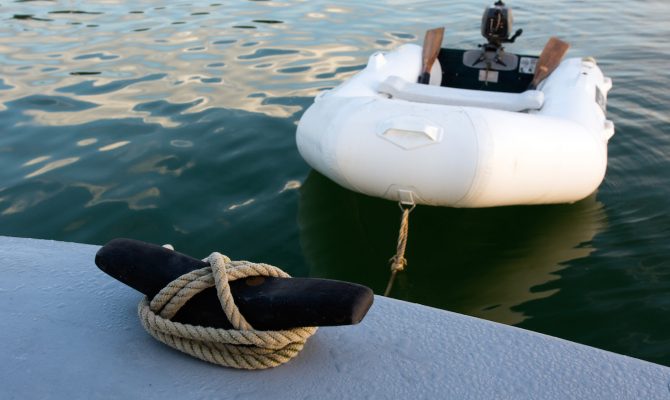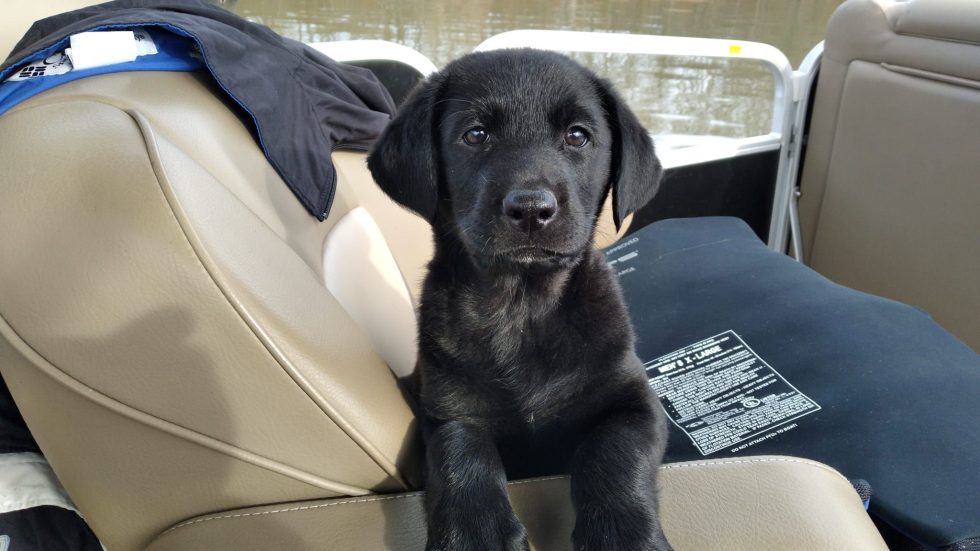Bridling from the mother ship is what works best. I’ll take the heaviest line that can wrap around my stern cleats, secure it to one and then run it to the other — outside of anything I have hanging off the stern of course — and wrap the line around the second cleat leaving a good coil as a tail. The towline, which should be polypropylene or Dacron, is secured to the bridle with a bowline knot; thus, when the strain is taken, the towline will find the center of the bridle. (Don’t know how to tie a bowline? See the sidebar.)
The towline is a fixed length: figure two or three dinghy lengths. Any adjustments will be made by lengthening the bridle, as one end is wrapped around the aft cleat and can be fed out, making sure, of course, to hitch it securely once the tow is sufficiently deployed.
I mention polypropylene because it’s strong for its diameter and floats, thus avoiding the prop. The downside is that polypropylene is susceptible to deterioration from the sun and abrasion and needs to be inspected regularly. It’s also slippery, and any knots need to be double-hitched and regularly eyeballed.
Dacron works because it doesn’t have the stretch of nylon, which can slingshot, propelling itself or a torn-off cleat into the back of your head and thus possibly ruining your day. On the other hand, when unattended, Dacron can find its way to your prop like a twister finds a trailer park.
Supporting Lines
As mentioned, the towline length can be adjusted by easing or taking up on the bridle. If you must run on plane (which I don’t think is a good idea when towing) the towline can be adjusted so the dinghy rides the backside of the stern wave in a somewhat bow-up position.
Bridling the dinghy is impractical. I’d bend the towline directly to the towing cleat on the dinghy — reinforced on the inflatable and well-backed on the solid dinghy, of course. It’s always a good idea to have supporting lines on the dinghy running to lateral strong points, so if the towing cleat lets go, the dinghy won’t go south right away.
What often does go south is the dinghy’s outboard. Ideally, the outboard is removed when towing. Obviously, if you’re hauling a 20-foot RIB with a 50-horsepower engine aft, this is impractical. If the outboard must stay on the dinghy, need I say that the lower unit should be out of the water? And — I don’t know the physics here, but it’s true — the strain on the stern mounts is increased when under tow. Therefore, it’s a good idea to have supporting lines run from the outboard to strong points aboard the dinghy.
Beyond the Tow
So, what are the options to towing? Davits, obviously. There are enough varieties out there that a little research will determine if that’s what works for you. When looking at davits, however, and knowing the heft of the dinghy you’ll be lifting, keep in mind that davit installation needs to be approached carefully. Consider backing plates and the potential for strain on hull and decking that might not have been designed to take such stresses.
And in that same line of research, there are lightweight, non-inflatable, folding dinghies on the market that are relatively easy to deploy, row and will take a small outboard. Full disclosure here: I own one, love it and will never tow again if I can help it.
This gives me the opportunity to rant about one of my favorite subjects — your basic inflatable. I have yet to find the inflatable that can be efficiently rowed in any kind of wind or chop, and I can’t imagine an outboard that I’d trust my life to. Therefore, I would suggest that any time we climb into our outboard-powered inflatable dinghy, we ask ourselves, “If this outboard was to die, what would I do? Would I be able to row this dinghy to safety in questionable conditions?”
If the answer is “no,” unless your boating takes place in lily ponds, I would seriously consider the alternatives.
Tying a Bowline Knot
The bowline is used to form a fixed loop at the end of a rope. It’s both easy to tie and untie and has many uses on board boats. Here’s how to do it in four simple steps:

- Lay the rope across your hand with the free end hanging down. Form a small loop in the line in your hand.
- Bring the free end up to and pass through the eye from the under side (the rabbit comes out of the hole).
- Wrap the line around the standing line and back down through the loop (the rabbit goes around the tree and back down the hole).
- Tighten the knot by pulling on the free end while holding the standing line.
Author: Stu Reininger is a regular contributor to HeartLand Boating magazine.



